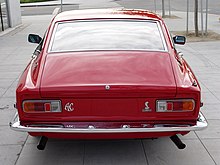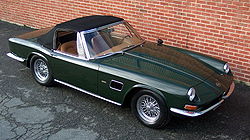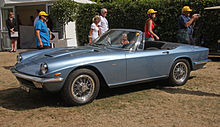AC 428
| AC | |
|---|---|
|
AC 428 Convertible (initially with wire-spoke wheels as standard)
|
|
| 428 | |
| Production period: | 1967-1973 |
| Class : | Sports car |
| Body versions : | Cabriolet , coupé |
| Engines: |
Petrol engines : 7.0 liters (254–287 kW) |
| Length: | 4470 mm |
| Width: | 1727 mm |
| Height: | 1245 mm |
| Wheelbase : | 2413 mm |
| Empty weight : | 1430 kg |
| Previous model |
AC Greyhound / AC Cobra |
| successor |
AC 3000ME / AC Ace Brooklands |
The AC 428 was a sports car offered in closed and open form by the British car manufacturer AC Cars , which was produced between 1965 and 1973.
Development history
The traditional British vehicle manufacturer AC Cars has been known for small sports cars since the 1950s. These included the AC Ace and AC Aceca models , which were offered with different engines of British origin. Derived from this, the AC Greyhound was created in 1959 , a four-seater Gran Turismo , of which fewer than 100 were produced. The company, headed by Charles and Derek Hurlock at the time, wanted to build on this tradition with a new model in the mid-1960s after it had achieved fame and some prosperity through the construction of the brute AC Cobra . The idea was to equip the well-known and proven chassis of the AC Cobra - slightly longer - and to equip the large eight-cylinder Ford engine also used in the Cobra with an elegant GT body, thus making the Cobra more mature. With this vehicle, AC wanted to enter the luxury vehicle market and compete with manufacturers such as Aston Martin , Bristol and Jensen .
The design
Charles and Derek Hurlock decided early on to have the body of the new Gran Turismo designed in Italy. After initial discussions with Bertone , the Carrozzeria Frua in Turin finally received the order in April 1965 . The first prototype, a two-seater convertible, was shown at the International Motor Exhibition in London in October 1965 , followed by the presentation of the 428 Coupé with a fastback body (“Fastback”) in Geneva in March 1967 . Against this background, the AC 428 is often, but not officially, called AC Frua.
The body design of the new AC was by no means independent. Pietro Frua , a master at using his creations several times, clearly repeated the lines of the Maserati Mistral he designed in 1963 , and the first-generation Monteverdi High Speed 375 , presented a little later, also showed clear similarities. On the other hand, many design features of the AC 428 can already be found on the one-off AC MA-200, completed in 1962 and designed by AC itself, which was originally intended to replace the AC Ace, AC Aceca and AC Greyhound models and that through contacts with the Swiss AC importer Patthey was also known to various Italian coachbuilders.
The proportions of the three models are essentially the same; The front design of Mistral and 428 are also largely the same. There are sources that also claim that the same body parts or attachments were used for all three vehicles; this applies, for example, to the doors, the glass sections and bumpers.
The design of the vehicles was sometimes independent in detail; sometimes bumpers and radiator openings in the style of the Jaguar E-Type were used, sometimes the position of indicators, mirrors or the like varied. Here some things were individually tailored to customer requirements. The Berlin designer Luigi Colani dressed a 428 convertible according to his own ideas in the 1980s.
The technology

The tubular frame of the AC 428 corresponded to that of the AC Cobra Mark III, but was extended by 150 mm between the axles, resulting in a wheelbase of 2413 mm. The chassis was also similar to that of the Cobra: all wheels were individually suspended on double wishbones of unequal length with coil springs arranged around the shock absorbers , plus rack and pinion steering and Girling disc brakes on both axles.
First the 6997 cm³ eight-cylinder engine from Ford was installed, which was known from the AC Cobra 427 and (according to SAE standard) delivered 385 hp (287 kW) at 5600 rpm. It was given to the first five convertibles and some coupes. In March 1968, Ford's “428” engine with a displacement of 7014 cm³ was switched to, which in the version used (“Ford Police Interceptor”) developed 345 hp (257 kW) at 4600 rpm. All vehicles produced later received this engine. The power was transmitted either by a four-speed gearbox with manual transmission from Ford or a - much more frequently ordered - three-speed automatic transmission from Ford (Type C6) and a Salisbury limited-slip differential .
The production
Series production of the AC 428 Convertible began at the end of 1966, and production of the coupé began six months later.
The production process was cumbersome. AC initially manufactured rollable chassis in Thames Ditton ( Great Britain ). They were then shipped by train to Pietro Frua in Turin , where the body was made and connected to the chassis. The dressed vehicles then came back. AC took on the “finish” there, that is, the installation of the interior and the paintwork. The production process was time consuming and largely responsible for the high price of the AC 428.
The AC 428 was offered as a new vehicle until the summer of 1973. During this time, 29 convertibles and 49 coupés were built; In addition, three other vehicles are said to have been built, the design of which is not known. The new price for a coupe in 1968 was £ 4,050, the convertible was £ 200 more expensive. In terms of price, the AC 428 corresponded to the Aston Martin V8 I , but at the end of its production period it exceeded its price considerably.
Production of the AC 428 ended in the summer of 1973. There were many reasons for this. On the one hand, the AC was very expensive; on the other hand, the market for large and fast sports cars collapsed in view of the looming oil crisis, so that even competitors like Aston Martin or Jensen had a hard time surviving. There were also difficulties with Ford as the engine purchase agreement was limited to the end of this year and Ford was not interested in extending it. After all, various strikes in Italy had repeatedly hampered the production of the bodies and repeatedly led to delays in delivery, which was not conducive to the image of the car and the brand.
After 1973 there was initially no direct successor to the 428 at AC. The next new model, the AC 3000ME , did not go into series production until 1979, but it had a mid-engine design, a 3.0 Ford V6 engine and a slightly lower price a different class of buyers. More conceptually similar was the AC Ace (Brooklands) , a two-seater convertible that AC Cars Group Ltd. under the direction of the South African Alan Lubinsky, after the retirement of the Hurlock family, built a small series of around 59 vehicles from 1996 to 1999 with American Ford technology.
Most of the AC 428 still exist today; Only the whereabouts of five convertibles and six coupés can no longer be clarified.
Special models
AC 428 II
In the spring of 1973 Pietro Frua designed a revised AC 428 Convertible, which was commissioned by Charles and Derek Hurlock and which was possibly intended as a successor to the previous model. The main difference between the cabriolet and the version produced so far was the newly designed front section. Instead of the round headlights, it had a slightly sloping line in which pop-up headlights were housed. The front bumper was now in one piece, and the indicators and parking lights were above the bumper. The few known photographs do not reveal any further changes. A series production of the vehicle did not materialize; the Hurlock family stopped production of the 428 while the modified model was being developed. The one-off 428 II Convertible was not completed until around ten years later and was painted red. It still exists today and is privately owned.
AC 429
Another special model is the AC 429. Unlike the AC 428, it is a four-seater coupé. This model is not actually an AC, and there was initially no technical relationship to the AC 428. Rather, from a technical point of view, it was a Monteverdi , which was introduced in 1969 under the name AC.
The starting point for the creation of this unique item was a dispute between Peter Monteverdi and Pietro Frua, who had been designing and producing bodies for the Swiss car manufacturer since 1967. As a supplement to the two-seater Monteverdi 375 / S High Speed, which was produced in series, Frua initially produced an extended 2 + 2-seater coupé with a hatchback body on behalf of Monteverdi in 1968, which was named Monteverdi 375 / L High Speed. The vehicle was received with some enthusiasm by the public. While Pietro Frua started producing a second 375 / L shortly afterwards, a dispute with Peter Monteverdi broke out over the outstanding payment of license fees and the business relationship was ultimately terminated. While Monteverdi turned to Carrozzeria Fissore , Frua kept the second, not completely completed 2 + 2 chassis in their own factory. A year later, AC owners Charles and Derek Hurlock became interested in this model and commissioned Frua to complete it and equip it as an AC. Frua installed a few changes - including Iso Lele- style semi-covered pop-up headlights - as well as some AC branding emblems. There were no further modifications.
Instead of the original drive unit from Chrysler , the AC 429 received that of the AC 428. With a view to series production, the vehicle at AC in Thames Ditton was also gradually converted to chassis components from the AC 428, so that ultimately there were no longer any technical similarities to the Monteverdi.
The car was initially registered for Derek Hurlock, but as a handcrafted one-off item, it had inadequacies such as leaks in the area of the windows and the body. A series production did not come about for cost reasons. The unique piece still exists today in private ownership and has been extensively restored for several years.
Replicas
The in Cornish St Austell based company Triple C Challenger Cars 1989 announced the reconstruction of the AC at 428 Convertible. The vehicle should be delivered as a kit. In the specialist literature, it is doubted that series production has gone beyond the prototype.
The AC 428 today
The prices are high, but in some cases they are well below the amounts paid for vehicles from Italian or British competitors. In addition, the AC does not even come close to the prices of a classic Cobra with a comparable engine. In May 2010 the 428 Coupé with the chassis number CF065 was auctioned for € 100,800.
Well-known drivers of the AC 428
The AC 428 was an elite vehicle that appealed to some members of the - mainly British - celebrities. These included:
- Luigi Colani
- Keith Moon , drummer for The Who
- Rob Walker , the owner of a British motorsport racing team
Trivia
A red 428 Convertible was used in the sixth season of the British television series With Umbrella, Charm and Melon in a total of eight episodes as the official car of agents John Steed ( Patrick Macnee ) and Tara King ( Linda Thorson ). The vehicle used was the prototype manufactured in 1965.
literature
- Frank Oleski, Rainer W. Schlegelmilch and Hartmut Lehbrink: Gericke's 100 - 100 years of sports cars . Düsseldorf 2005, ISBN 3-938118-00-8 .
- The Big Book of Sports Cars ; Erlangen 1990 (no ISBN)
- John McLellan: Classic ACs . Sutton Publishing Ltd., Stroud, Gloucestershire 2000, ISBN 978-0-7509-2042-1 (English).
- Simon Taylor, Peter Burn: AC Heritage: From the Three-Wheeler to Superblower . Osprey Publishing Ltd. (UK), Botley, Oxford 2000, ISBN 978-1-85532-875-4 (English).
Web links
Individual evidence
- ↑ The AC 428 predecessor AC MA-200 on the Conceptcarz.com website
- ↑ http://www.zeperfs.com/en/fiche5275-ac-428-frua-coupe-auto.htm
- ↑ http://www.lov2xlr8.no/brochures/others3/67ac/bilder/5.jpg
- ↑ Steve Hole: AZ of Kit Cars. The definite encyclopaedie of the UK's kit car industry since 1949 , Haynes Publishing, Sparkford 2012, ISBN 978-1-84425-677-8 , p. 53.
- ↑ Note on the website of RM Auctions ( Memento of the original from April 10, 2010 in the Internet Archive ) Info: The archive link was inserted automatically and has not yet been checked. Please check the original and archive link according to the instructions and then remove this notice.







